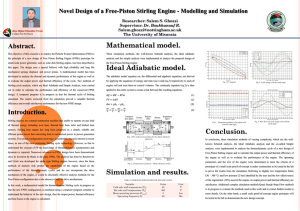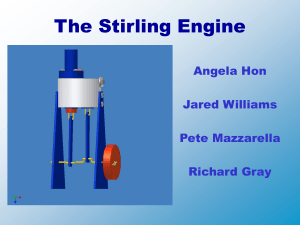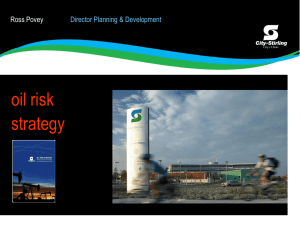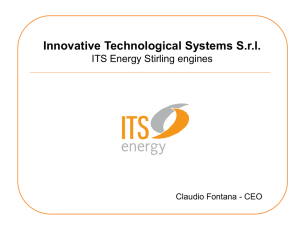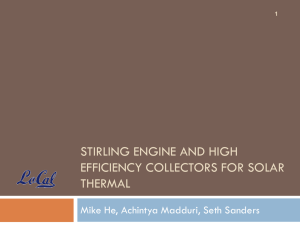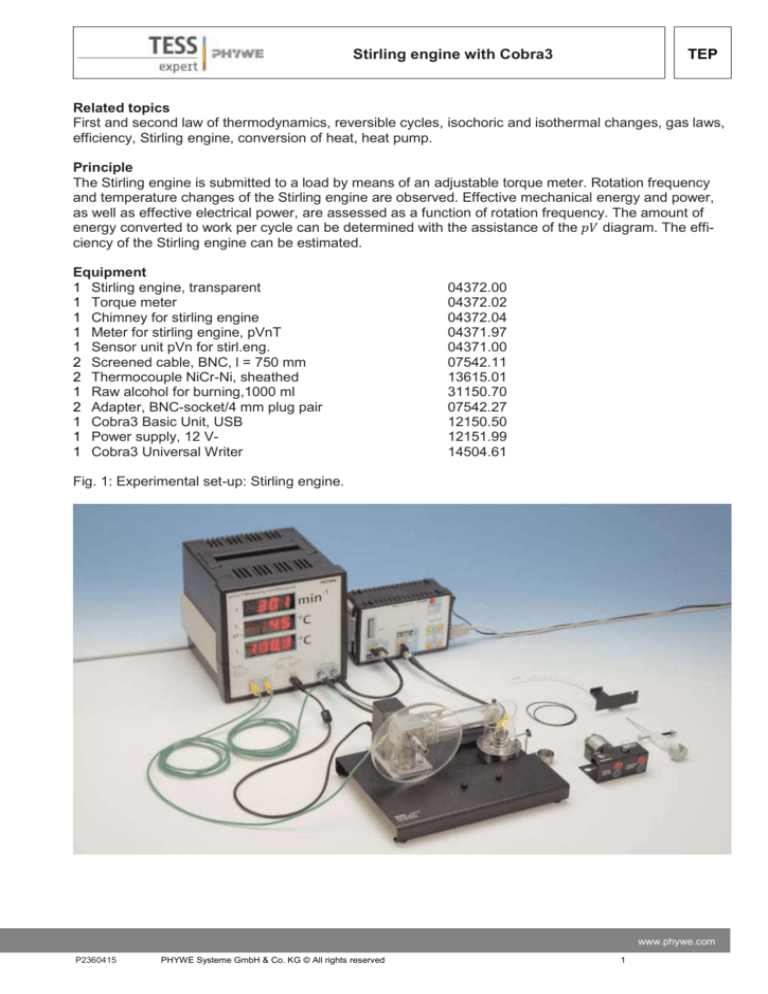
TEP
Stirling engine with Cobra3
Related topics
First and second law of thermodynamics, reversible cycles, isochoric and isothermal changes, gas laws,
efficiency, Stirling engine, conversion of heat, heat pump.
Principle
The Stirling engine is submitted to a load by means of an adjustable torque meter. Rotation frequency
and temperature changes of the Stirling engine are observed. Effective mechanical energy and power,
as well as effective electrical power, are assessed as a function of rotation frequency. The amount of
energy converted to work per cycle can be determined with the assistance of the 𝑝𝑉 diagram. The efficiency of the Stirling engine can be estimated.
Equipment
1 Stirling engine, transparent
1 Torque meter
1 Chimney for stirling engine
1 Meter for stirling engine, pVnT
1 Sensor unit pVn for stirl.eng.
2 Screened cable, BNC, l = 750 mm
2 Thermocouple NiCr-Ni, sheathed
1 Raw alcohol for burning,1000 ml
2 Adapter, BNC-socket/4 mm plug pair
1 Cobra3 Basic Unit, USB
1 Power supply, 12 V1 Cobra3 Universal Writer
04372.00
04372.02
04372.04
04371.97
04371.00
07542.11
13615.01
31150.70
07542.27
12150.50
12151.99
14504.61
Fig. 1: Experimental set-up: Stirling engine.
www.phywe.com
P2360415
PHYWE Systeme GmbH & Co. KG © All rights reserved
1
TEP
Stirling engine with Cobra3
Tasks
1. Determination of the burner ’s thermal power.
2. Calibration of the sensor unit.
3. Calculation of the total energy produced by the engine through determination of the cycle area in the
p-V diagram recorded with the Cobra3 unit.
4. Assessment of the mechanical work per revolution, and calculation of the mechanical power output as
a function of the rotation frequency with the assistance of the torque meter.
5. Efficiency assessment.
Set-up and procedure
Experimental set up should be carried out as shown in Fig.1. The base plate (mounting plate) of the Stirling engine must be removed, so that the latter can be fixed on the corresponding mounting plate of the
𝑝𝑉𝑛 sensor unit. The incremental transmitter of the 𝑝𝑉𝑛 sensor unit is to be firmly connected to the axle
of the Stirling engine. The latter is then fixed upon the large base plate.
Before switching on the 𝑝𝑉𝑛𝑇 meter, make sure it is connected to the 𝑝𝑉𝑛 sensor. Connect the p exit to
the "Analog In 2
/ S2" and the V exit to the "Analog In 1 / S1" input of the Cobra3 Basic Unit. Connect the Cobra3 Basic
Unit to the USB port. After switching on, the 𝑝𝑉𝑛𝑇 meter display shows “cal”. Both thermocouples should
have the same temperature.
By pressing the “Calibration T”-button they are calibrated (i.e. setting them to the same temperature value). This calibration of the temperature sensors sets the temperature difference display to zero and does
not affect the absolute temperature display. The upper display now shows “OT”, which means “upper
dead centre point ”. At this position, the engine is at its minimum volume - i.e. the working piston should
be at its lowest position. Bring the piston down by turning the engine axle by hand and press the “Calibration V ” button. Wrong calibration will cause a phase shift in the volume output voltage, and thus lead
to a distortion of the 𝑝𝑉 diagram. The three displays should now be on, showing 0 revs/min, and the actual temperatures for 𝑇1 and 𝑇2 .
1. THERMAL OUTPUT OF THE BURNER
The amount of alcohol in the burner is measured before and after the experiment with a measuring glass
or the used amount is determined by weighing the burner before and after the experiment noting down
the weight difference. The corresponding duration of the experiment is recorded with a watch or clock.
2. CALIBRATION OF THE PRESSURE SENSOR
The pressure sensor must be calibrated so that the 𝑝𝑉 diagram can be evaluated quantitatively. Start the
"measure" program on your computer and select the gauge "Cobra3 Universal Writer". For pressure calibration you may use the "Normal Measurement" with the settings seen in Fig. 2.
Loosen the little flexible tube leading to the pressure sensor with the Stirling engine in a well-defined piston position, e.g. the "upper dead centre point", where the working piston is all the way down and the
volume in the engine minimal. Fix the tube on again. Now the pressure in the engine is equal to the outer
pressure of appr. 1013 hPa and the volume in the engine is 32 cm3. (with the piston all the way up, the
volume is 44 cm3). Start the measurement with the "Continue" button and turn the engine slowly and
steadily by hand some cycles to have nothing but isothermal modification with the air inside the engine
so that p · V = const.. There must be no phase displacement between volume and pressure! Stop the
measurement and scale the volume axis by selecting "Analysis" > "Channel modification…" (Fig. 3) to
the real volume with
f := 32 + U1 * 12/5
(1)
since the voltage 𝑈1 changes between 0 and 5 Volt with the piston displacement from 32 to 44 cm3 (difference 12 cm3) engine volume.
2
PHYWE Systeme GmbH & Co. KG © All rights reserved
P2360415
TEP
Stirling engine with Cobra3
Fig. 2.: Settings for pressure calibration
Fig. 3: Channel modification
www.phywe.com
P2360415
PHYWE Systeme GmbH & Co. KG © All rights reserved
3
TEP
Stirling engine with Cobra3
If you take the OT as point with same pressure as surrounding, you can derive the pressure p by p · V =
const. = 1013 hPa · 32 cm3. The values delivered by the channel modification
f := 1013 * 32/V
(2),
which you set to p, can you compare then to the U2 voltage by reading out the values with the "Survey"
tool (or by using "Measurement" > "Channel manager…" putting the U2 values to the x-axis and the
pressure values to the y-axis The slope of the p – U2 diagram yields the calibration factor.) Your calibration factor will be some hundred hPa (or mbar) per Volt and U2 will read something around 2.5 Volt at
surrounding pressure, e.g. the suitable channel modification may look like
f := 1013 + (U2 – 2,25) * 235
(3)
where you put the actual reading of U2 at surrounding pressure instead of 2,25 and your actual calibration factor instead of the 235.
As an alternative, you can calibrate the pressure sensor with a syringe connected to the little flexible
tube. For more details refer to the experimental manual for the version without Cobra 3 (LEP 3.6.04-00).
3. TOTAL ENERGY AND 𝒑𝑽 DIAGRAM
Start the burner, note down the time, and after some heating you can start the engine with a shove on
the fly-wheel. Begin measurements always after rotation frequency and both temperature values have
steadied. Select the "Fast Measurement" chart and use settings like the ones seen in Fig. 4.
Fig. 4: Measurement settings
4
PHYWE Systeme GmbH & Co. KG © All rights reserved
P2360415
TEP
Stirling engine with Cobra3
Record a curve with the "Continue" button. The recorded curves may look like Fig. 5. Scale the volume
and pressure curves by "Analysis" > "Channel modification…" with your actual formulas analogue to (1)
and (3). Save the curves to have a backup for further data manipulation.
Fig. 5: Measurement example before converting the voltage to the entities to be measured
Cut the curves so that only one complete cycle of the curves is left using the marking tool (the cross
symbol next to the magnifying glass) and the cutting tool (scissor symbol). Use "Measurement" > "Channel manager…" and put the volume to be the x-axis set and put the pressure to be the y-axis set. See
Fig. 6. In the then appearing "Convert relation to function" window select "Keep measurement in relation
mode".
Fig. 6: Using the channel manager on the cut curves
www.phywe.com
P2360415
PHYWE Systeme GmbH & Co. KG © All rights reserved
5
TEP
Stirling engine with Cobra3
The "Show integral" button can be used for evaluating the cycle surface. The result may look like Fig.7.
The cycle has a surface of 2510 mbar · cm3 = 2510 hPa · cm3 =
= 2510 · 100
𝑁
· 10−6 m3 = 251 mJ
𝑚2
Fig. 7: Cycle in the 𝑝𝑉 diagam
4. EFFECTIVE MECHANICAL ENERGY
In order to load the engine with a determined torque, the scale of the torque meter is fixed on the large
base plate, and the inner metallic piece of the pointer is fixed on the axis before the fly-wheel. Friction
between the pointer and the connected metallic piece can be varied by means of the adjusting screw on
the pointer. Adjustment must be done carefully, to make sure that the pointer does not begin to oscillate.
Start carrying out measurements with a low torque. After each adjustment, wait until torque, rotation frequency and temperatures remain constant. All values and the 𝑝𝑉 diagrams are to be recorded.
Theory and evaluation
In 1816, Robert Stirling was granted a patent for a hot air engine, which is known today as the Stirling
engine. In our times, the Stirling engine is used to study the principle of thermal engines because in this
case the conversion process of thermal energy to mechanical energy is particularly clear and relatively
easy to understand.
At present, the Stirling engine is undergoing a new phase of further development due to its many advantages.
Thus, for example, it constitutes a closed system, it runs very smoothly, and it can be operated with
many different heat sources, which allows to take environmental aspects into consideration, too.
6
PHYWE Systeme GmbH & Co. KG © All rights reserved
P2360415
TEP
Stirling engine with Cobra3
Fig. 8a: 𝑝𝑉 diagram for the ideal Stirling process.
Theoretically, there are four phases during each engine cycle (see. Fig. 8a and 8b):
1) An isothermal modification when heat is supplied and work produced
p1 → p2
𝑉1 → 𝑉2
and 𝑇1 = const.
2) An isochoric modification when the gas is cooled:
𝑇1 → 𝑇2
p2 → p3
and 𝑉2 = const.
3) An isothermal modification when heat is produced and work supplied:
p3 → p4
𝑉2 → 𝑉1
and 𝑇12 = const.
4) An isochoric modification when heat is supplied to the system:
𝑇2 → 𝑇1
p4 → p1
and 𝑉1 = const.
According to the first law of thermodynamics, when thermal energy d𝑄 is supplied to an isolated system,
its amount is equal to the sum of the internal energy increase d𝑈 of the system and the mechanical work
𝑝d𝑉 supplied by the latter:
d𝑄 = d𝑈 + 𝑝d𝑉
www.phywe.com
P2360415
PHYWE Systeme GmbH & Co. KG © All rights reserved
7
TEP
Stirling engine with Cobra3
It is important for the Stirling cycle that the thermal energy produced during the isochoric cooling phase
be stored until it can be used again during the isochoric heating phase (regeneration principle).
It is important for the Stirling cycle that the thermal energy produced during the isochoric cooling phase
be stored until it can be used again during the isochoric heating phase (regeneration principle).
Fig. 8b: Functioning of the transparent Stirling engine.
8
PHYWE Systeme GmbH & Co. KG © All rights reserved
P2360415
TEP
Stirling engine with Cobra3
Thus, during phase IV the amount of thermal energy released during phase II is regeneratively absorbed. This means that only an exchange of thermal energy takes place within the engine. Mechanical
work is merely supplied during phases I and III. Due to the fact that internal energy is not modified during
isothermal processes, work performed during these phases is respectively equal to the absorbed or released thermal energy.
Since 𝑝 · 𝑉 = 𝜈 · 𝑅 · 𝑇,
where 𝜈 is the number of moles contained in the system, and R = 8.31 J/(mol K) the general gas constant, the amount of work produced during phase I is:
𝑊1 = − 𝜈 · 𝑅 · T1 · ln (V2 /𝑉1 )
(it is negative, because this amount of work is supplied).
Consequently, the amount of work supplied during phase III is
𝑊3 = + 𝜈 · 𝑅 · T2 · ln (V2 /𝑉1 )
|𝑊1 | > 𝑊3 because 𝑇1 > 𝑇2
The total amount of work is thus given by the sum of 𝑊1 and 𝑊3 . This is equal to the area of the 𝑝𝑉 diagram:
𝑊t = 𝑊1 + 𝑊3
𝑊t = – 𝜈 · 𝑅 · 𝑇1 · ln (𝑉2 /𝑉1 ) + 𝜈 · 𝑅 · 𝑇2 · ln (𝑉2 /𝑉1 )
𝑊t = – 𝜈 · 𝑅 · (𝑇1 − 𝑇2 ) · ln (𝑉2 /𝑉1 )
Only a part of this total effective energy 𝑊t can be used as effective work 𝑊m through exterior loads applied to the engine. The rest contains losses within the Stirling engine.
The maximum thermal efficiency of a reversible process within a thermal engine is equal to the ratio between the total amount of work I𝑊1 I and the amount of supplied thermal energy 𝑄1 = – 𝑊1
𝜂𝑡ℎ = 𝑊𝑡 /𝑊1
𝜂𝑡ℎ =
𝜈 ∙ 𝑅 ∙ (𝑇1 − 𝑇2 ) ∙ In (𝑉2 /𝑉1 )
𝜈 ∙ 𝑅 ∙ 𝑇1 ∙ In (𝑉2 /𝑉1 )
𝜂𝑡ℎ =
𝑇1 − 𝑇2
𝑇1
Carnot found this to be the maximum thermal efficiency for any thermal engine, which can only be
reached theoretically.
One sees that efficiency increases with increasing temperature differences.
1. Thermal power of the burner
Duration
∆𝑡 = 60 𝑚𝑖𝑛
Amount of alcohol burned
∆𝑉 = 29 𝑚𝑙
Alcohol density
𝜌 = 0.83 𝑔/𝑚𝑙
Specific thermal power
ℎ = 25 𝑘𝐽/𝑔
www.phywe.com
P2360415
PHYWE Systeme GmbH & Co. KG © All rights reserved
9
TEP
Stirling engine with Cobra3
This allows to determine the mass of alcohol burnt per second:
∆𝑚
= 6.69 · 10−3 g/s
∆𝑡
as well as the thermal power of the burner: 𝑃H = 167 W.
2. 𝑝𝑉 diagram surface
Fig. 9 shows two real 𝑝𝑉 diagrams for a Stirling engine with and without load (Fig. 9a: no load, Fig. 9b:
with a load M of 18.3 · 10-3 Nm). Assessed surface values are given in table 2.
For other Stirling engines, the 𝑝𝑉 diagram may have a somewhat different shape. Thus, for example, the
surface is a function of supplied thermal power and engine friction at equilibrium rotation frequency.
Comparison of the 𝑝𝑉 diagrams for an engine submitted or not to an exterior load shows that a higher
pressure difference occurs for the load case, corresponding to the larger temperature difference measured at the Stirling engine. If the engine is submitted to a load, the surface of the 𝑝𝑉 diagram increases
merely by 10%–20%; it displays a maximum for the total effective energy 𝑊pV at medium loads or medium rotation speeds respectively (see Fig.10).
3. Effective mechanical energy and power
Effective mechanical energy during a cycle is calculated with the assistance of the torque M displayed by
the torque meter:
Wm = 2 · 𝜋 · 𝑀
The displayed rotation speed n (revolutions per minute) is converted to the frequency 𝑓 (revolutions per
second). This allows us to determine the mechanical power:
𝑃m = 𝑊m · 𝑓
Fig. 9: Real 𝑝𝑉 diagrams (a) without, and (b) with exterior load.
10
PHYWE Systeme GmbH & Co. KG © All rights reserved
P2360415
TEP
Stirling engine with Cobra3
Table 1 contains measured and calculated values. Fig. 10 displays the total effective energy 𝑊pV assessed on the base of the 𝑝𝑉 diagram, effective mechanical energy 𝑊m as well as friction energy per cycle 𝑊fr , as a function of rotation frequency.
𝑊fr = 𝑊pV – 𝑊𝑚
Rotation frequency reaches its maximum value when the engine is not submitted to exterior loads (here:
982 min-1). It is a function of thermal input and friction; in general its values lie within the range
800…1000 min-1. Rotation frequency decreases with increasing exterior loads, until the Stirling engine
stops (in general between 150…300 min-1). Temperature T1 increases strongly with decreasing rotation
frequencies; T2 decreases a little due to the fact that the air in the regenerator (that is on the wall of the
displacing piston) is pre heated or respectively cooled to a better extent when rotation frequency is low.
Pressure within the Stirling engine also varies with temperatures. This is clearly visible on the 𝑝𝑉 diagram (see Fig. 9). When adjusting a new torque, load fluctuations and shocks on the axle are unavoidable. Due to this, measurement values may display a large range of scattering. Friction energy per cycle
increases with rotation frequencies.
Effective mechanical power displays a marked peak for rotation frequencies within a range of 500…600
min-1 (see Fig. 10).
www.phywe.com
P2360415
PHYWE Systeme GmbH & Co. KG © All rights reserved
11
TEP
Stirling engine with Cobra3
Fig. 10: Mechanical energy as a function of rotation frequency.
4. Real and ideal Stirling process, efficiency assessment
The idealised Stirling process runs along isochoric and isothermal lines (see Fig. 8a). The real process
can stray considerably from this, due to several reasons:
a. Both pistons run with a constant phase shift of 90°, which causes the diagram to have no sharp
angles, as in the case of the idealised process.
b. Gas velocity is too high for an isothermal change of state in the case of an engine running at 1000
revs/ min.
c. The regenerator does not work at 100% efficiency. The air within the Stirling engine reaches the
cold zone warmer, and the warm zone colder, as would be the case for the ideal process. Larger
thermal input and cooling capacity are required.
d. During the ideal process, the total amount of working medium is forced from the cold zone into the
warm zone. In the real process, there is a clearance volume, e.g. in the case of this Stirling engine
the regenerator volume (that is the volume next to the displacing piston), and in the working cylinder.
e. There are large losses of pressure, as the working piston is not air tight.
f. Friction losses occur at all friction surfaces and within the streaming gas.
Isotherms can be adapted to a measured 𝑝𝑉 diagram with the assistance of the measured temperatures
𝑇1 and 𝑇2 . This is carried out, using a measurement in the maximum power range of the Stirling engine
as an example.
𝑀 = 18.3 · 10−3 Nm
𝑇1 = 192°C = 465 K
𝑇2 = 75.5°C = 349 K
12
PHYWE Systeme GmbH & Co. KG © All rights reserved
P2360415
TEP
Stirling engine with Cobra3
The following relation is valid for an ideal gas:
𝑝 · 𝑉 = 𝜈 · 𝑅 · 𝑇
Due to the fact that the working piston of the Stirling engine is not air tight, the number of moles n contained within the engine during operation must be evaluated with the assistance of the 𝑝𝑉 diagram (see
Fig. 9). One or two points are selected in the middle of the diagram surface. They are allocated to the
isotherm at the average temperature:
𝑇m =
𝑇1 + 𝑇2
2
= 407 K.
Example:
1st point: 𝑉 = 38.0 𝑐𝑚3
𝑝 = 969 hPa
corresponds to this
2nd point: 𝑝 = 1017 hPa
𝑉 = 36.8 cm3
corresponds to this
With 𝑅 = 8.31 J/(mol K), one obtains, as an average of both assessments:
𝜈 = 1.10 · 10-3 moles
The isotherms for temperatures 𝑇1 and 𝑇2 , calculated with the assistance of this value, are represented
in Fig. 11, together with the 𝑝𝑉 diagram. When comparing measured and theoretical curves, it must be
taken into account that the displayed temperatures only can be average values. In the vicinity of the
flame, temperature is higher than 𝑇1 and lower than 𝑇2 within the working cylinder. Volume increase only
takes place within the cold working cylinder; for this reason average temperatures are shifted towards
lower values than those displayed for a large volume, and the curve of the 𝑝𝑉 diagram is somewhat
steeper than the isotherms. Overlapping may also occur when comparing various 𝑝𝑉 diagrams with theoretical curves.
Efficiency assessment for this maximum power example:
The effective energy per cycle is (see Table 1):
𝑊m = 115 mJ
During one cycle, the burner supplies the following thermal energy:
𝑊H = 𝑃H /𝑓
𝑊H = 18.0 J
This yields a total efficiency of:
𝜂 = 𝑊m /𝑊H
𝜂 = 115 mJ/18.0 J
𝜂 = 0.6%
The efficiency of the Stirling engine is constituted by several components:
Efficiency of the heater:
www.phywe.com
P2360415
PHYWE Systeme GmbH & Co. KG © All rights reserved
13
TEP
Stirling engine with Cobra3
𝜂H = |𝑊1 |/𝑊2
𝜂H
𝜂H
𝑉
(𝑉2 )
= 𝜈 ∙ 𝑅 ∙ 𝑇1 In 1
𝑊H
1.35 J
=
18.0 J
𝜂H = 7.5%
Thermal efficiency (Carnot):
𝜂th = 𝑊𝑡 /
𝑊1
𝜂th = (𝑇1 − 𝑇2 )⁄𝑇1
𝜂th=(465 K−349 K)/465 = 25%
Fig. 11: 𝑝𝑉 diagram and isotherms.
Interior efficiency:
𝜂i = 𝑊pV / |𝑊t |
𝜂i = 𝑊pV /(𝜈 · 𝑅 (𝑇1 – 𝑇2 ) ln (𝑉2 /𝑉1 )
𝜂i = 245 mJ/339 mJ = 72%
Mechanical efficiency:
𝜂m = 𝑊m /𝑊pV
𝜂m = 115 mJ/245 mJ = 47%
14
PHYWE Systeme GmbH & Co. KG © All rights reserved
P2360415
TEP
Stirling engine with Cobra3
Fig. 12: Stirling engine with accessories for heating by the sun.
Note
The experiments can also be performed with the help of the sun as heating source. Therefore you need
the accessories for solar motor work. The setup is shown in Fig. 12.
For conversion of the energy generated by the Stirling motor to electric energy and to drive the Stirling
motor as a heat pump or as a refrigerating machine you can use the motor/generator unit 04372.01. For
further details refer to its manual or the experimental manual for the version without Cobra 3 (LEP
3.6.04-00).
Fig. 13: Motor/generator unit
www.phywe.com
P2360415
PHYWE Systeme GmbH & Co. KG © All rights reserved
15

